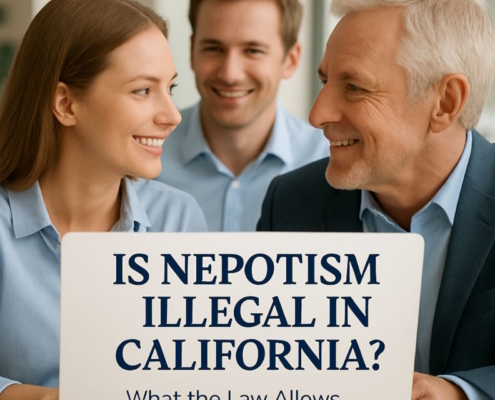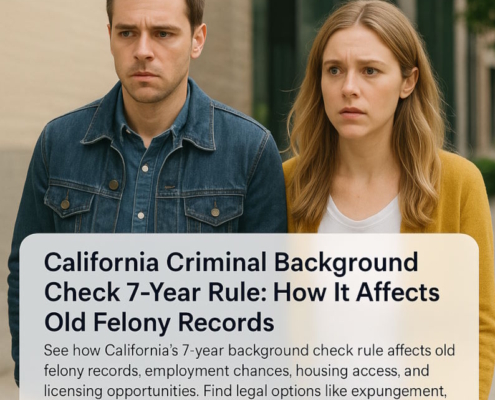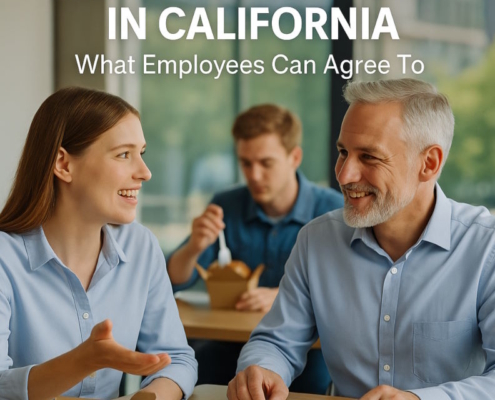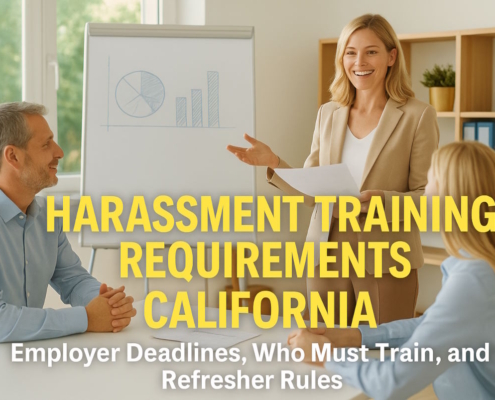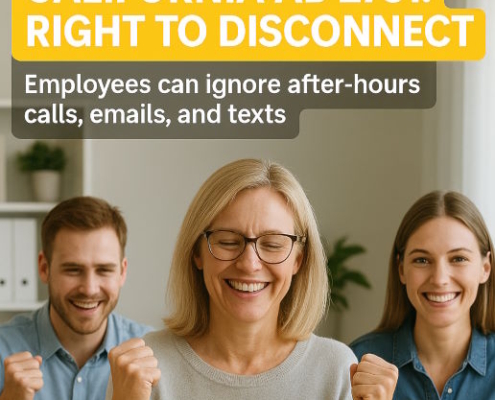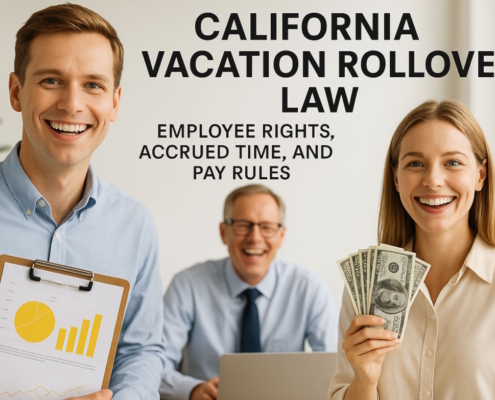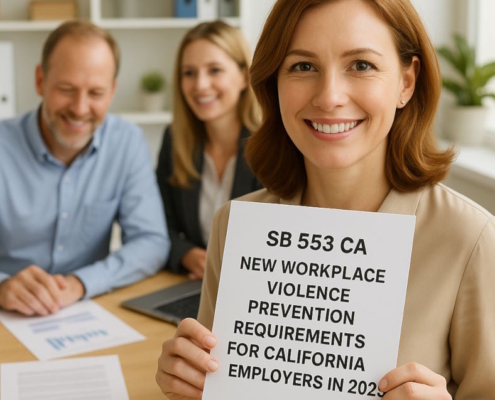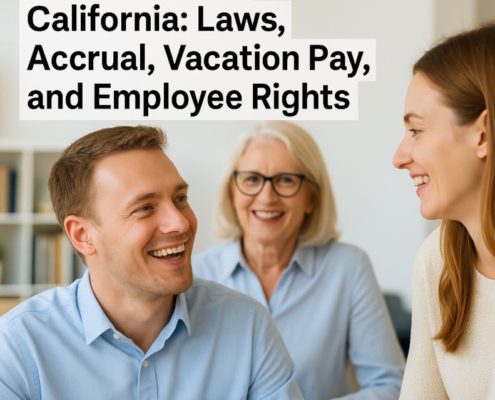Wrongful Discharge in Violation of Public Policy
By Brad Nakase, Attorney
Email | Call (800) 484-4610
Definition. Wrongful termination from employment is tortious when the termination occurs in violation of a fundamental public policy. (Gantt v. Sentry Ins. (1992) 1 Cal. App. 4th 1083, 1090; Gould v. Maryland Sound Industries, Inc. (1995) 31 Cal. App. 4th 1137.)
If you’re an employer and an employee sued your company, please contact our employment lawyer for a free consultation to defend your business.
Elements: To establish a claim of wrongful discharge in violation of public policy under California law, a plaintiff must show:
- That she was terminated from her employment;
- That the termination was a violation of public policy, for example, that there was a nexus between the termination and the plaintiff’s status or protected activity, and;
- Damages. (Anthoine v. North Cent. Counties Consortium (E.D. Cal. 2008) 571 F.Supp.2d 1173.)
Tort claims for wrongful discharge under California law typically arise when an employer retaliates against an employee for (1) refusing to violate a statute, (2) performing a statutory obligation, (3) exercising a statutory right or privilege, or (4) reporting an alleged violation of a statute of public importance. (Anthoine v. North Cent. Counties Consortium (E.D. Cal. 2008) 571 F.Supp.2d 1173.)
Four Categories Involving Public Policy
“[T]he cases in which violations of public policy are found generally fall into four categories:
- Refusing to violate a statute;
- Performing a statutory obligation;
- Exercising a statutory right or privilege; and
- Reporting an alleged violation of a statute of public importance.” (Gantt v. Sentry Ins. (1992) 1 Cal. 4th 1083, 1090.)
FEHA. California Fair Employment and Housing Act’s (“FEHA”) provisions prohibiting discrimination may provide the policy basis for a claim for wrongful discharge in violation of public policy. (Estes v. Monroe (2004) 120 Cal.App.4th 1347.) “FEHA’s policy prohibiting disability discrimination in employment is sufficiently substantial and fundamental to support a claim for wrongful termination in violation of public policy.” (Rope v. Auto-Chlor System of Washington, Inc. (2013) 220 Cal.App.4th 635, 660.)
Violation of Public Policy CACI 2430: Elements of Wrongful Termination
Paula claims she was discharged from employment for reasons that violate a public policy. It is a violation of public policy to discharge someone from employment for refusing to engage in price fixing. To establish this claim, Paula must prove:
- That Paula was employed by defendant Daniel;
- That Daniel discharged Paula;
- That Paula’s refusals to engage in price fixing was a substantial motivating reason for Paula’s discharge;
- That Paula was harmed; and
- That the discharge was a substantial factor in causing Paula’s harm.
Existence of Employer-Employee Relationship Necessary
There must be an employer-employee relationship to pursue a claim for wrongful termination in violation of public policy. Independent contractors are not protected. (Varisco v. Gateway Science & Engineering, Inc. (2008) 166 Cal.App.4th 1099, 1103; Ali v. L.A. Focus Publication (2003) 112 Cal.App.4th 1477, 1484-1485.)
The plaintiff may only pursue his or her claim of wrongful termination against an employer, not a co-worker or supervisor. (Khajavi v. Feather River Anesthesia Med. Group (2000) 84 Cal.App.4th 32, 53; Cf. Gov. Code, § 12940, subd. (j)(3) [individual supervisors may be held liable for discriminatory harassment]; but see Jones v. Lodge at Torrey Pines Partnership (2008) 42 Cal.4th 1158 (“we conclude that the employer is liable for retaliation under section 12940, subdivision (h), but nonemployer individuals are not personally liable for their role in that retaliation.”].)
Element 1: Termination of Employment
The plaintiff must be fired, discharged, or terminated. Daly v. Exxon Corp. (1997) 55 Cal. App. 4th 39, 45 [former employee brought claim for wrongful termination after one-year employment contract was not renewed].)
Employer Must Actually or Constructively Terminate Employment
The defendant in a wrongful discharge in violation of public policy complaint must actually or constructively terminate plaintiff’s employment. (Gantt v. Sentry Ins. (1992) 1 Cal. App. 4th 1083, 1086-87 [plaintiff constructively terminated for refusal to give false testimony in administrative sexual harassment investigation]; Tameny v. Atlantic Richfield Co. (1980) 27 Cal. 3d 167, 169-70.)
The “gravamen of the wrongful termination action is the violation of some personal right considered to be of fundamental public importance … not the financial or economic loss from the termination of employment.” (Barton v. New United Motor Mfg., Inc. (1996) 43 Cal. App. 4th 1200, 1208-09.)
“[A]n employee need not prove an actual violation of law; it suffices if the employer fired him for reporting his ‘reasonably based suspicions’ of illegal activity.” (Green v. Ralee Engineering Co. (1998) 19 Cal.4th 66, 87.)
Element 2: Violation of Fundamental Public Policy
In order to prevail on a wrongful termination claim under California law, a plaintiff must plead and prove as one element of that claim that a fundamental public policy exists that is delineated in constitutional or statutory provisions. (Scott v. Solano County Health and Social Services Dept. (E.D. Cal. 2006) 459 F.Supp.2d 959.)
Fundamental Public Policy Defined
A policy is “fundamental” when it is carefully tethered to a policy delineated in constitutional or statutory provisions affecting the public at large. (Gantt v. Sentry Ins. (1992) 1 Cal. App. 4th 1083, 1090; Gould v. Maryland Sound Industries, Inc. (1995) 31 Cal. App. 4th 1137, 169-70.)
The policy in question must involve a matter that affects society at large rather than the purely personal or proprietary interest of the employee or employer. (Ibid.)
The policy in question must be a policy about which reasonable persons can have little disagreement. (Foley v. Interactive Data Corp. (1988) 47 Cal. 3d 654, 668.)
“[T]ermination of an employee most clearly violates public policy when it contravenes the provision of a statute forbidding termination for a specified reason….” (Diego v. Pilgrim United Church of Christ (2014) 231 Cal.App.4th 913, 926.)
Requirements for “Public Policy”
To support a tortious discharge claim, the public policy must be supported by either constitutional or statutory provisions; public in the sense that it “inures to the benefit of the public” rather than serving merely the interests of the individual; articulated before or at the time of the discharge; and fundamental and substantial. (Stevensen v. Superior Court (1997) 16 Cal. 4th 880, 890.)
Must Regulate More Than Conduct Between Private Individuals
“Policies are not ‘public’ (and thus do not give rise to a common law tort claim) when they are derived from statutes that ‘simply regulate conduct between private individuals, or impose requirements whose fulfillment does not implicate fundamental public policy concerns.’ ” (Diego v. Pilgrim United Church of Christ (2014) 231 Cal.App.4th 913, 926.)
Examples An employer who constructively discharges an employee in retaliation for his refusal to testify untruthfully or his refusal to withhold testimony in the course of a DFEH investigation has violated a fundamental public policy. (Gantt v. Sentry Ins. (1992) 1 Cal. 4th 1083, 1096.)
The termination of an employee because he refused to commit perjury before a legislative committee was a fundamental public policy violation. (Petermann v. International Brotherhood of Teamsters (1959) 174 Cal. App. 2d 184, 189.)
Discharging an employee for union membership and activity was a fundamental public policy violation. (Glenn v. Clearman’s Golden Cock Inn, Inc. (1961) 192 Cal. App. 2d 793.)
“[A]n employer’s authority over its employee does not include the right to demand that the employee commit a criminal act to further its interests, and an employer may not coerce compliance with such unlawful directions by discharging an employee who refuses to follow such an order….” (Tameny v. Atlantic Richfield Co. (1980) 27 Cal. 3d 167, 178.) Terminating an employee for the refusal of plaintiff to be involved in an illegal gasoline price-fixing scheme was a fundamental public policy violation. (Ibid.)
Discharging an employee for protesting a “hazardous working condition” caused by employees smoking in the workplace was a fundamental public policy violation. (Hentzel v. Singer Co. (1982) 138 Cal. App. 3d 290, 295-96.)
Terminating an employee to avoid paying him his accrued compensation and in retaliation for reporting overtime wage violations was a fundamental public policy violation. (Gould v. Maryland Sound Industries, Inc. (1995) 31 Cal. App. 4th 1137, 1146; see also Phillips v. Gemini Moving Specialists (1998) 63 Cal. App. 4th 563 [Labor Code sections mandating prompt payment of wages and prohibiting deductions from pay without consent set forth a fundamental and substantial public policy protecting an employee’s wages].)
Sex discrimination in employment may support a claim of tortious discharge in violation of public policy. (Kelley v. The Conco Cos. (2011) 196 Cal.App.4th 191, 214.) “In sum, a wrongful termination against public policy common law tort based on sexual harassment can be brought against an employer of any size.” (Kim v. Konad USA Distribution, Inc. (2014) 226 Cal.App.4th 1336, 1351.)
Element 3: Causation and Damage
The termination must cause the plaintiff to suffer injury, damage, loss or harm. (Tameny v. Atlantic Richfield Co. (1980) 27 Cal. 3d 167, 1147.)
“It would be nonsensical to provide a different standard of causation in FEHA cases and common law tort cases based on public policies encompassed by FEHA.” (Mendoza v. Western Medical Center Santa Ana (2014) 222 Cal.App.4th 1334, 1341.)
Note: FEHA does not supplant other state law claims, including common law claims, relating to employment discrimination. Thus, a plaintiff employee need not exhaust FEHA administrative procedures before bringing a non-statutory common law claim, such as this one. (See Rojo v. Kliger (1990) 52 Cal. 3d 65, 90.)
A plaintiff must establish a nexus between the protected conduct and the employer’s adverse treatment. (Turner v. Anheuser-Busch, Inc. (1994) 7 Cal. 4th 1238, 1258 [plaintiff’s claim of whistle-blower harassment failed because he could not demonstrate the required nexus between his reporting of statutory violations and adverse treatment by the employer; plaintiff’s whistle-blowing activity occurred at least 4 years before the performance review that caused him to quit].)
“[S]ubstantial motivating reason” has been held to be the appropriate standard for cases alleging termination in violation of public policy. (Alamo v. Practice Management Information Corp. (2013) 219 Cal.App.4th 466, 479; see Harris v. City of Santa Monica (2013) 56 Cal.4th 203, 232.)
“To establish a claim for wrongful termination in violation of public policy, an employee must prove causation. (See CACI No. 2430 [using phrase ‘substantial motivating reason’ to express causation].) Claims of whistleblower harassment and retaliatory termination may not succeed where a plaintiff ‘cannot demonstrate the required nexus between his reporting of alleged statutory violations and his allegedly adverse treatment by [the employer].’ ” (Ferrick v. Santa Clara University (2014) 231 Cal.App.4th 1337, 1357.)
Statute of Limitations
The statute of limitation for wrongful termination claims is two years from the date of termination. (Cal. Code Civ. Proc., § 335.1; see generally Prue v. Brady Company/San Diego, Inc. (2015) 242 Cal.App.4th 1367, 1382 [holding that wrongful termination in violation of public policy claims are not barred by the FEHA’s one-year statute of limitations because the two-year statute for tort actions applies].)
Remedies
“[W]hen an employer’s discharge of an employee violates fundamental principles of public policy, the discharged employee may maintain a tort action and recover damages traditionally available in such actions.” (Tameny v. Atlantic Richfield Co. (1980) 27 Cal.3d 167, 170.)
Compensatory Damages
The plaintiff may recover damages if he or she demonstrates that the Defendant engaged in discriminatory practice or discriminatory practices with malice or with reckless indifference. (See Gantt v. Sentry Ins. (1992) 1 Cal. 4th 1083.)
Lost Compensation
Back Pay. Back pay restores a plaintiff in a wrongful termination case to the position he or she would have occupied but for the wrongful termination. (Lozada v. City and County of San Francisco (2006) 145 Cal.App.4th 1139.)
Front Pay. Front pay as the term is used in employment litigation, is a measure of damages for loss of future income, as opposed to backpay, which is lost-wages damages through the time of trial. If the judge orders reinstatement of a fired employee, front pay might be awarded to make up a wage differential if there were no vacancy into which the employee could immediately be reinstated or promoted. (Horsford v. Board of Trustees of California State University (2005) 132 Cal.App.4th 359.)
Punitive Damages. Where an action is pleaded for wrongful termination in violation of public policy, the same opportunity to plead and recover punitive damages exists. (See Gantt v. Sentry Ins. (1992) 1 Cal. 4th 1083.)
Attorneys’ Fees and Costs
The court, in its discretion, may award to the prevailing party, including the department, reasonable attorney’s fees and costs, including expert witness fees. (Gov. Code, § 12965, subd. (b).)
Affirmative Defenses
After-Acquired Evidence Doctrine. (Camp v. Jeffer, Mangels, Butler & Marmaro (1995) 35 Cal.App.4th 620, 632-35 [after-acquired evidence doctrine shields employer from liability or limits available relief where, after termination, employer learns for the first time about employee wrongdoing that would have led to discharge in any event].)
Employee’s Duty to Mitigate Damage. “The general rule is that the measure of recovery by a wrongfully discharged employee is the amount of salary agreed upon for the period of service, less the amount which the employer affirmatively proves the employee has earned or with reasonable effort might have earned from other employment. However, before projected earnings from other employment opportunities not sought or accepted by the discharged employee can be applied in mitigation, the employer must show that the other employment was comparable, or substantially similar, to that of which the employee has been deprived; the employee’s rejection of or failure to seek other available employment of a different or inferior kind may not be resorted to in order to mitigate damages.” (Parker v. Twentieth Century-Fox Film Corp. (1970) 3 Cal.3d 176, 181-182; see also Rabago-Alvarez v. Dart Industries, Inc. (1976) 55 Cal.App.3d 91, 98 [“Plaintiff concedes that the trial court was entitled to deduct her actual earnings”]; but see Villacorta v. Cemex Cement, Inc. (2013) 221 Cal.App.4th 1425, 1432 [wages actually earned from an inferior job may not be used to mitigate damages].)
Have a quick question? We answered nearly 2000 FAQs.
See all blogs: Business | Corporate | Employment
Most recent blogs:




